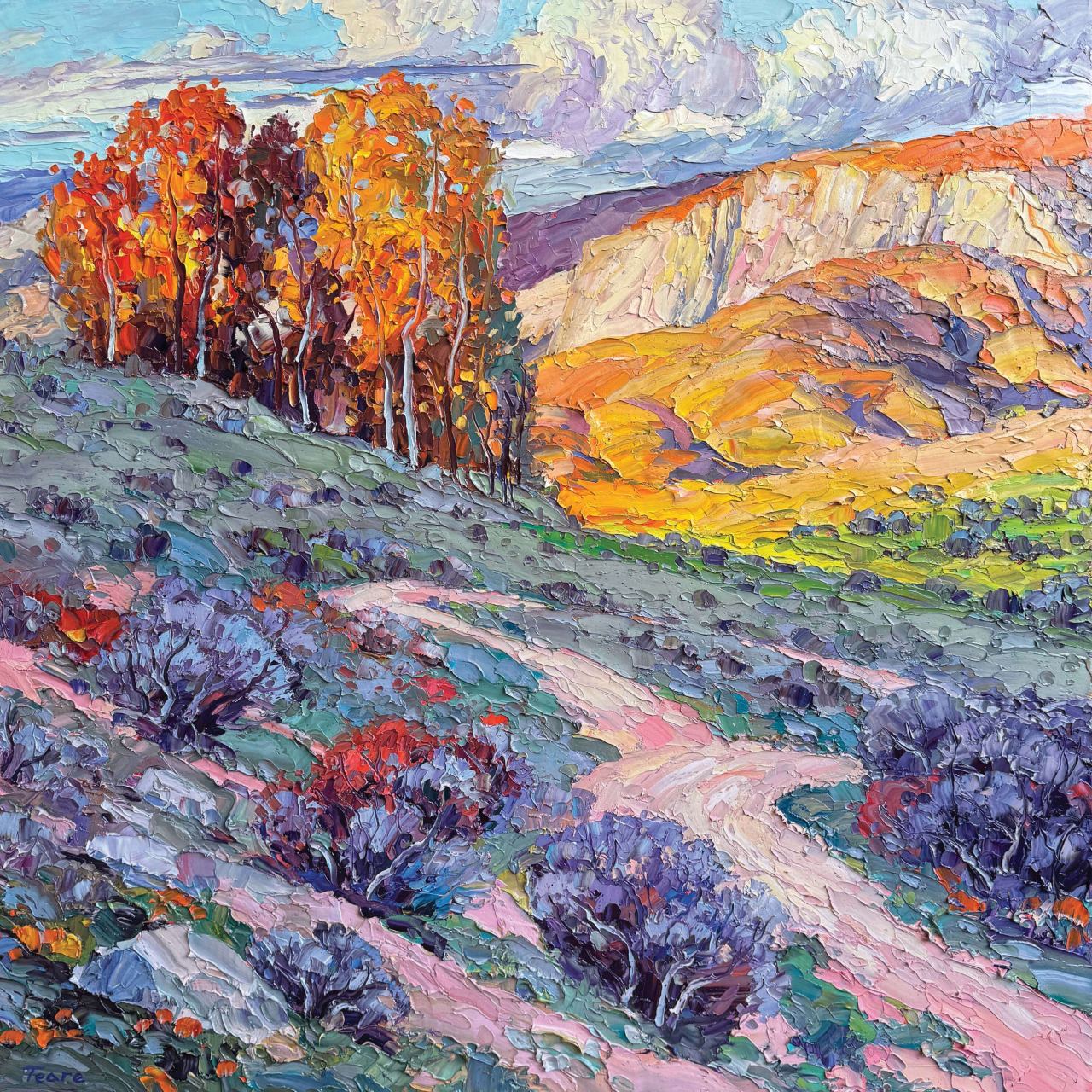
08 Mar Declarations of the Palette Knife
Landscape painter Brad Teare draws his visual inspiration from the intimate valleys and snowy mountain peaks around his home in Northern Utah’s glorious Cache Valley.
However, perhaps the real subject of Teare’s impressionist work is the paint itself — the paint and the artist’s ability to push, move, pull, form, curve, mold, shape, and fashion it across once-white canvases using a standard-issue, titanium Holbein palette knife. Teare has worked his entire career to perfect this technique.
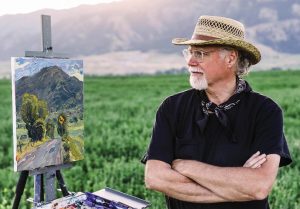
Photo by Amy Elizabeth
“It’s a physical thing for me,” says Teare. “There’s an energy to it, a flow. I really enjoy working from the shoulder. You can’t hold a palette knife and render like you would with a pencil. The painting comes from the shoulder as you sweep across the canvas instead of using your arm to render large, all-consuming strokes. There is a broadness to it all that I love.”
“Brad is a talented artist who has mastered the art of using texture to bring life and emotion to his paintings,” says Cyndi Hall, associate director of Manitou Galleries in Santa Fe, New Mexico. “He easily portrays space and depth through his impasto approach. Teare’s passion for using texture goes beyond just the physical elements of his paintings. He sees texture as a way to convey emotion and mood, adding depth and complexity to his pieces.”
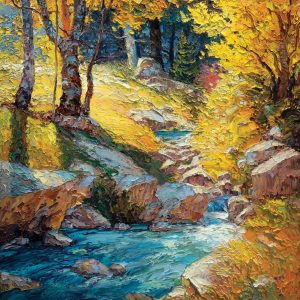
Autumn Glow | Oil on Canvas | 40 x 40 inches
Teare began his career as an illustrator and lived in New York City with his late wife, Debra. While in the city, Brad worked for The New York Times and Random House, among others, creating book covers and illustrations for such novelists as James Michener, Anne Tyler, and Alice Walker. However, after the dot.com boom and bust, Teare became disillusioned with the industry’s increasing reliance on the computer, so he remembered his longing to become a landscape painter, packed his supplies, and headed back to Utah to start a fine art career.
Early on, Teare became fascinated with woodcuts and painting in oils and acrylics. Like his later work with a palette knife, woodcuts offered a physically demanding medium that had dimensionality, surfaces, textures, and the ability to be handcrafted. “My mind just worked that way,” says Teare. “And I had a knack for that art form. Cutting, carving, sculpting — it’s all the activity I enjoy.”
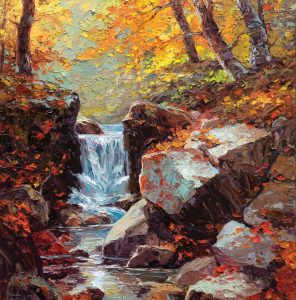
Autumn Cascade | Oil on Canvas | 48 x 48 inches
Then, around 2006, Teare was preparing for a new art show. He had been working with paint but was adding things like marble dust to make it thicker and more conducive to capturing the details he found in the natural world — the lichen, tree bark, and moss on the side of a rock. But Teare was finding that the pigment was getting harder and harder to move around.
“I had been doing them small, like studies,” says Teare. “But I had a show at Alpine Gallery in Salt Lake City at the time, and the gallery owner said, ‘Why don’t you just do them big and more abstract.’ So, I picked up a palette knife, and I was hooked. It combined all the physicality of the woodblocks with the energy and drama of the oil painting. I was obsessed.”
For Teare, painting with a palette knife offered him everything he wanted in an art form. It was a strange transition for him, but maneuvering paint around, fixing an edge, and pushing paint shapes was exactly the type of work that fed his brain.
“The first pieces were more abstract, and I experimented a lot,” says Teare. “I was moving mass amounts of thick paint around the canvas, and I loved that. I wanted to explore the texturing process. At first, I used acrylics since they allow unlimited layers and bizarre texturing mediums without the threat of cracking. I studied combinations of color and texture using a unique painting process that frequently employed mediums such as fumed silica, calcium carbonate, and marble dust.”
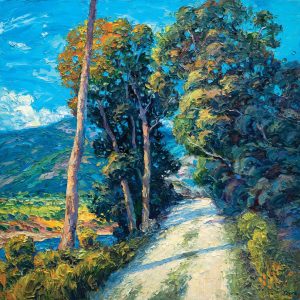
Autumn Sojourn | Oil on Canvas | 36 x 36 inches | 2023
The landscapes around his home in the Cache Valley became the perfect subject for Teare’s experimentation with spreading thick chunks of paint around the canvas. The multitude of colors found in nature — whether the sweeping vastness of a sky or the intricate details of a single tree — allowed him to load up his knife with a variety of colors and push, pull, or sweep the blade across the canvas. “For example, if I’m painting a leaf, I’ll load the palette knife with three colors, and all colors blend together, red to yellow to green, and I can put them all down with one stroke. There is an economy to it, but it also creates these amazingly vibrational things. When you get a good stroke, and you have three colors vibrating in harmony, it becomes like a chord in music. One note, and it all works. The palette knife creates a rich texture of oppositional colors that vibrate harmoniously against each other.”
Miracle of Autumn is a large painting that was featured at the Eiteljorg Museum’s 2022 Quest for the West Show & Sale. The painting features a road near Mount Sterling in Cache Valley. It was Teare’s idea to focus on a mundane scene but infuse it with his color and composition.
“The autumn leaves on the tree branches, the pattern made by the negative shapes of the branches, and the road all come together to create a beautiful journey for the eyes. Sometimes, the paint on the foliage is built up so much that when I go back to lay the color of the branch, I carve out a trough of color with the palette knife. Then, I’ll go back and lay down another color in that same trough.”
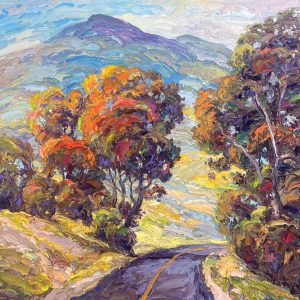
Miracle of Autumn | Oil on Canvas | 36 x 36 inches
This mastery of color and composition is something collectors find appealing as well. “With his landscapes, the textured brush strokes create a sense of rough terrain or turbulent skies,” says Hall. “His unique style has garnered him a loyal following of collectors at Manitou Galleries.”
With this new technique, Teare finds that the thick impasto paint creates a dimensionality not found when working with other painting styles. “When you look at one from the side, you see these large dollops of paint,” says Teare. “What I think about when I’m painting is the viewer of the work and what happens when they walk into a gallery and see the work for the first time. I want the design to shine through.”
Collector Ira Friedman lives and works in New York City but visits Santa Fe several times a year. He, too, became fascinated with woodblock prints, and that’s how he stumbled across Teare’s work. He has grown to love his landscape paintings and even travels with Teare on painting trips throughout the Southwest.
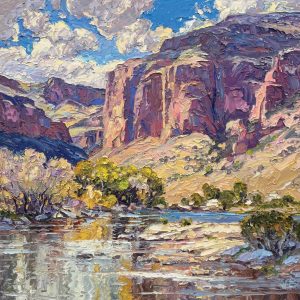
Red Rock Canyon, Afternoon | Oil on Canvas | 40 x 40 inches
“I love where he is going with these new works,” says Friedman. “They are so labor intensive, and I appreciate what he does with the paint and palette knife. He has a fabulous eye for landscapes, settings, and color. I just love them.”
Teare sees a successful painting as something with three levels of appeal that come from viewing a canvas from various distances and seeing something differently each time. “From 50 feet away, that’s the design level, and you see the basic design of shapes,” says Teare. “From 5 feet, you see the linear qualities — a tree, a mountain, the things themselves. And from 5 inches away, you see the abstract quality of the paint strokes. When I’m in the studio, I find myself moving around a lot. Stepping back from a distance. You learn a lot about your work by stepping back and just looking.”






No Comments